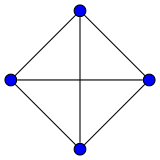Platonic graph

The platonic graphs can be seen as Schlegel diagrams of the platonic solids. (excluding the square pyramid also shown here)
In the mathematical field of graph theory, a Platonic graph is a graph that has one of the Platonic solids as its skeleton. There are 5 Platonic graphs, and all of them are regular, polyhedral (and therefore by necessity also 3-vertex-connected, vertex-transitive, edge-transitive and planar graphs), and also Hamiltonian graphs.[1]
- Tetrahedral graph – 4 vertices, 6 edges
- Octahedral graph – 6 vertices, 12 edges
- Cubical graph – 8 vertices, 12 edges
- Icosahedral graph – 12 vertices, 30 edges
- Dodecahedral graph – 20 vertices, 30 edges
 |
 |
 |
 |
 |
See also
References
- ↑ Read, R. C. and Wilson, R. J. An Atlas of Graphs, Oxford, England: Oxford University Press, 2004 reprint, Chapter 6 special graphs pp. 261, 266.
External links
This article is issued from Wikipedia - version of the 1/31/2016. The text is available under the Creative Commons Attribution/Share Alike but additional terms may apply for the media files.